eISSN: 2093-8462 http://jesk.or.kr
Open Access, Peer-reviewed

eISSN: 2093-8462 http://jesk.or.kr
Open Access, Peer-reviewed
Kyeong-Hee Choi
, Yong-Ku Kong
, Hyunji Keum
, Seungjae Son
, Dokyeong Lee
, Hyunseok Yang
, Seoung-Yeon Kim
, Mintae Seo
, Hyun-Ho Shim
10.5143/JESK.2024.43.2.165 Epub 2024 May 07
Abstract
Objective: The aim of this study was to define the design factors of a lower-limb wearable exoskeleton that aids in reducing the workloads of elderly farmers.
Background: Musculoskeletal disorders related to agricultural work have been raised as a very important problem as the aging population progresses. Especially, the loads of back and lower-limb caused by squatting, and awkward posture like knee or back flexion posture are serious problems because most of the agricultural work consists of atypical work. Therefore, the need to develop a wearable lower-limb assistance device that can reduce the load on the lower extremities caused by agricultural work has recently emerged.
Method: In this study, the design of the lower-limb wearable exoskeleton device was classified into three parts: 'thigh support'; 'calf support'; and 'knee joint' connecting thigh and calf supports. First, hip and knee heights, thigh, mid-thigh, and knee circumferences were used to define dimensions for the 'thigh support'. Second, calf height and lower knee, maximum calf, and minimum calf circumferences were used to define dimensions for the 'calf support'. The center height and circumference of each support were set based on these measurements. Finally, in the case of the 'knee joint', the length between the centers of the thigh and calf support was used.
Results: As a result, the specific dimensions were as follows based on the 8th Size Korea. For the 'thigh support', the center height was 623.7mm; upper, mid, and lower circumferences were 232.1mm (92.3R), 200.8mm (79.9R), and 173.4mm (69.0R), respectively. For the 'calf support', the center height was 318.6mm; upper, mid, and lower circumferences were 137.7mm (54.8R), 144.9mm (57.6R), and 115.1mm (45.8R), respectively. For the 'knee joint', the center height was 445.4mm; the length of the knee joint was 305.1mm.
Conclusion: In this study, design factors of lower-limb exoskeleton for agricultural work were defined. The lower-limb exoskeleton was classified into three parts: 'thigh support', 'calf support', and 'knee joint'. In the case of the support part, center height, and circumference were defined. Then, the length and angle of the knee joint were also defined.
Application: It is expected to develop a wearable lower-limb exoskeleton device that can be applied to actual agricultural work in the future through continuous improvement and usability evaluation.
Keywords
Lower-limb exoskeleton Wearable device Work-related musculoskeletal disorder (WMSDs) Agricultural work Elderly workers
작업관련 근골격계 질환(Work-related Musculoskeletal Disorders, WMSDs)은 작업 부담으로 인한 신체 부하 누적으로 인해 근육, 뼈, 관절 등에 발생하는 만성적인 손상 및 건강 장애이다. 근골격계 질환의 주요 원인은 무리한 힘의 사용, 반복적인 동작, 부적절한 작업 자세, 및 진동 등과 같은 다양한 위험요인에 지속적으로 노출되는 것이다. 또한, 근골격계 질환은 힘의 저하와 움직임의 제한 등을 동반하여 작업 및 일상생활에 많은 제약을 주며 허리, 목, 어깨 등의 다양한 신체 부위에 통증을 유발한다(Cohen, 1997; Punnett and Wegman, 2004).
근골격계 질환은 제조업, 농업, 건설업, 수송업 등 다양한 산업 분야에서 발생한다. 이 중 농업의 경우, 여러 농작물의 작업조건에 따라 허리를 구부리거나 쪼그려 앉는 자세, 무거운 수확물을 드는 자세 등과 같은 부자연스러운 자세로 장시간의 작업으로 인해 만성적 피로와 여러 건강 장애를 초래하고 있다(Ahn et al., 1985; Rural Development Administration, 1995). 또한, 대부분의 농작업이 비정형 작업으로 구성되어 있으며, 비정형 작업으로 인한 부적절한 자세의 빈도가 작업시간의 50% 이상을 차지하여(Lee, 2012), 허리 및 하지 부위의 작업 부담이 매우 심각하다고 보고된다(Meyers et al., 2000). 특히, 농작물 수확 작업을 수행할 때 하지 부위의 통증이 나타나는 경우가 많은데, 고추나 가지와 같은 지면으로부터 약 20~40cm의 높이에서 작업을 수행할 경우에는 무릎 굽힘의 각도가 130° 이상으로 발생하기 때문에 무릎 관절에 매우 큰 부하가 발생한다(Jung and Jung, 2005). 농작업의 이러한 문제점은 한국의 고령화가 진행됨에 따라 고령 농업인에 대한 안전과 보건에 있어서 매우 중요한 고려사항으로 제기되고 있다.
최근 근골격계 질환의 예방에 대한 해결책으로서 착용형 외골격 보조장치가 전 세계적으로 많은 관심을 받고 있다(De Looze et al., 2016; Toxiri et al., 2019). 착용형 외골격 보조장치는 신체에 부착하여 사람의 신체능력을 강화, 확장, 보완 및 대체할 수 있는 보조장치로(Ruiz, 2019), 군사용, 산업용, 재활 보조용 등 다양한 분야에서 활용되고 있으며(Lee et al., 2017; Steinhilber et al., 2022), 외골격의 작동 방식 또는 보조해주는 신체 부위에 따라 다양한 형태로 분류된다. 작동 방식에 따른 분류에서는, 전력, 유압, 공압과 같은 동력을 기반으로 신체를 보조해주는 active exoskeleton과 동력장치 없이, 구조물을 기반으로 신체를 지지 또는 보조해주는 passive exoskeleton으로 나뉘게 된다(De Looze et al., 2016, Howard et al., 2020). 보조해주는 신체 부위에 따른 분류에서는, 높은 작업점에서 어깨 들림과 같은 상지의 움직임을 지원해주는 upper-limb exoskeleton, 낮은 작업점에서 무릎 및 허리 굽힘 자세에 대한 부담을 경감해주는 lower-limb exoskeleton, 그리고 중량물을 들어올릴 때 허리의 부하경감을 위해 허리를 지지해 주는 lumbar support exoskeleton으로 총 3가지로 나눌 수 있다(Rashedi et al., 2014; Luger et al., 2019). 다만, 현재 개발되고 보급되고 있는 외골격들 중, 상대적으로 가볍고 저렴한 passive lower-limb exoskeleton들은 대부분 산업용이나 재활 보조용을 목표로 개발되어 있어, 대상 작업의 높이가 무릎 또는 그 이하의 높이가 많은 한국의 다양한 작물에 대한 농작업들에 적용하기에는 많은 한계가 있다. 또한 외골격 보조장치를 개발하고자 하는 다양한 연구들은 인체역학적인 요소나 보조장치의 작동 방식에만 초점을 맞추어 제작하여 신체치수를 고려하지 못한다는 한계가 존재한다(Di Natali et al., 2019; Zhou et al., 2020).
따라서 본 연구의 목적은 낮은 농작물을 대상으로 하는 한국의 농작업들을 수행하는 데 있어서, 고령자는 물론, 여러 농업인의 허리 및 무릎 굽힘 작업으로 인한 작업 부담의 경감을 위해, 한국 농업인의 신체치수를 반영한 하지 외골격 보조장치의 (1) 설계 디자인 요소들과 각 요소들의 치수들을 정의하고, 이 데이터를 활용하여 (2) 무릎 각도 조절이 가능한 한국형 하지 외골격 보조장치를 제작하고자 한다.
2.1 Definition of design factors for lower-limb exoskeleton
본 연구에서는 착용형 하지 외골격 보조장치의 제작을 위해, ① 허벅지 받침, ② 종아리 받침, 그리고 ③ 무릎 관절부 등 3개 부분으로 분류하였으며, 다양한 연령을 대상으로 설계하고자 평균적인 치수를 도출하여 착용의 사용성을 높이기 위해 Size Korea(8차; 2020~2023년) 20~69세 남녀의 인체치수 50%ile 데이터를 반영하여 외골격 보조장치들의 세부 설계 항목 및 치수 등을 설정하였다.
허벅지 받침과 종아리 받침의 경우, 받침의 높이, 길이, 그리고 둘레를 설정하기 위해 해당하는 신체 항목들을 고려하여 정의하였으며, 허벅지 받침부와 종아리 받침부를 연결하는 부위인 무릎 관절부의 높이와 각 받침부로부터 관절까지의 길이를 정의하였다. 추가적으로, 허벅지와 무릎이 이루는 각도를 반영하여 무릎 관절의 각도를 정의하였다. 구체적인 각 치수들의 정의는 Figure 1과 같다.
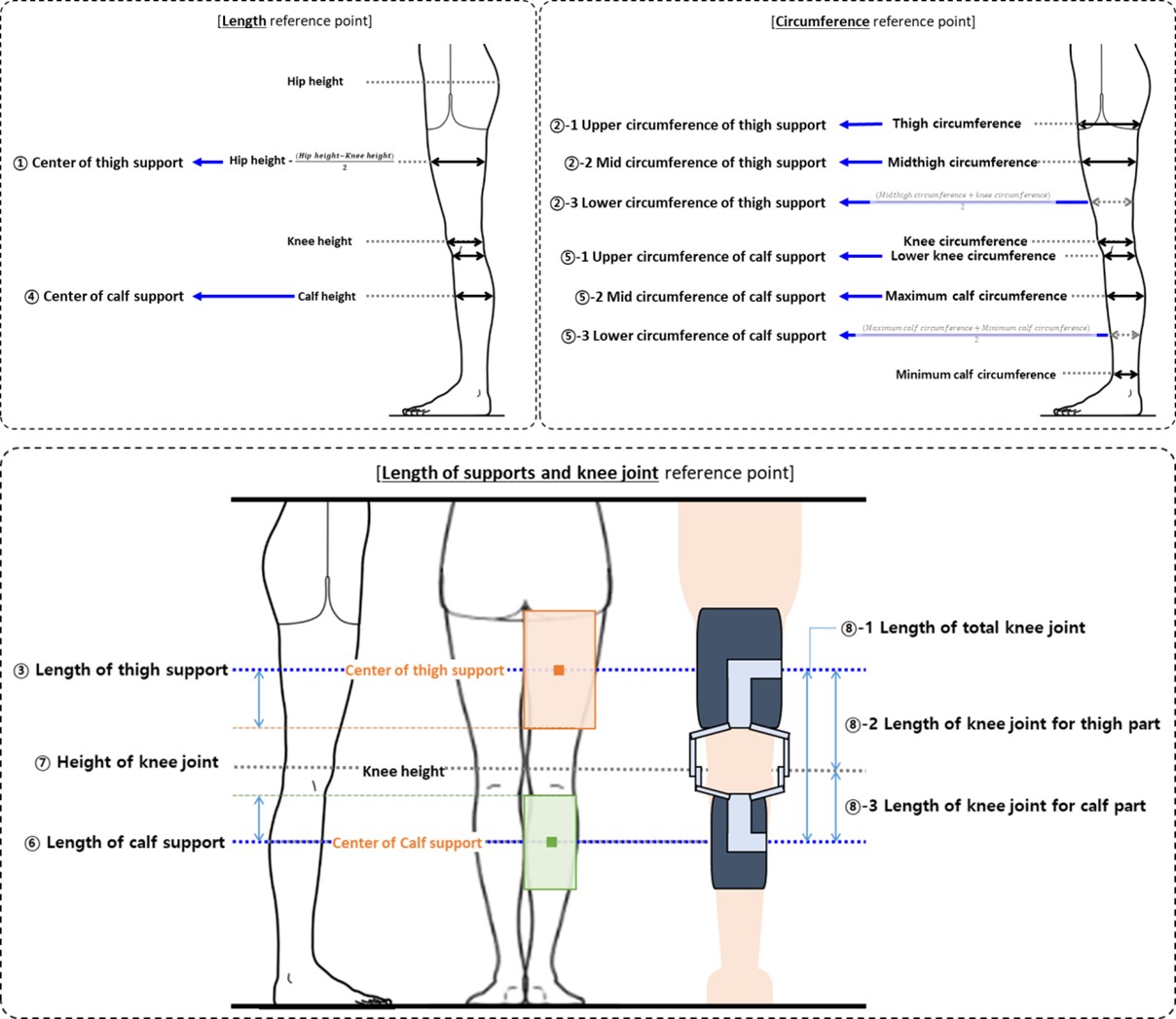
허벅지 받침
① 허벅지 받침 중심 높이(center height of thigh support)는 엉덩이높이(hip height)와 무릎높이(knee height)의 중간지점으로 설정하였으며, 그 결과, 허벅지 받침 중심 높이는 [엉덩이높이 – (엉덩이높이 – 무릎높이)/2]로 정의하였다.
② 허벅지 받침부 둘레(circumference of thigh support)는 위, 가운데, 아래 둘레로 분류하였다. 허벅지 받침부 둘레는 넙다리둘레(thigh circumference), 넙다리중간둘레(midthigh circumference), 무릎둘레(knee circumference)를 활용하여 곡률과 둘레를 설정하였다.
허벅지 받침 위 둘레는 [넙다리둘레], 가운데 둘레는 [넙다리중간둘레], 아래 둘레는 허벅지와 무릎의 중간지점의 둘레인 [(넙다리중간둘레 + 무릎둘레)/2]로 정의하였으며, 둘레의 경우에는 전체 둘레의 40%로 정의하였다.
③ 허벅지 받침 길이(length of thigh support)는 허벅지 받침 중심 높이와 무릎높이를 활용하였다. 해당하는 길이는 받침의 절반에 해당하기 때문에 전체 길이는 [(허벅지 받침 중심 높이 – 무릎높이)*2]로 정의하였으며, 허벅지의 착용감과 관절의 걸림을 고려하여 전체 길이의 70%로 정의하였다.
종아리 받침
④ 종아리 받침 중심 높이(center height of calf support)은 장딴지높이(calf height)로 설정하였다. 따라서 종아리 받침 중심 높이는 [장딴지높이]로 정의하였다.
⑤ 종아리 받침부 둘레(circumference of calf support) 또한 위, 가운데, 아래 둘레로 분류하였다. 종아리 받침부 둘레의 경우, 무릎아래둘레(lower knee circumference), 장딴지최대둘레(maximum calf circumference), 종아리최소둘레(minimum calf circumference)를 활용하여 곡률과 둘레를 설정하였다.
종아리 받침 위 둘레는 [무릎아래둘레], 가운데 둘레는 [장딴지최대둘레], 아래 둘레는 종아리 받침 가운데 둘레와 종아리의 가장 얇은 신체 부위의 중간지점 둘레인 [(장딴지최대둘레 + 종아리최소둘레)/2]로 정의하였으며, 둘레의 경우, 허벅지 받침과 동일하게 전체 둘레의 40%로 정의하였다.
⑥ 종아리 받침 길이(length of calf support)는 종아리 받침 중심 높이와 무릎높이를 활용하였다. 허벅지 받침과 마찬가지로 해당하는 길이는 받침의 절반에 해당하기 때문에 전체 길이는 [(무릎높이 – 종아리 받침 중심 높이)*2]로 정의하였다. 허벅지보다 상대적으로 얇은 종아리 부위의 안정적인 받침 역할을 위해 전체 길이의 80%로 정의하였다.
무릎 관절부
⑦ 무릎 관절부의 높이(height of knee joint)는 허벅지와 종아리를 연결하는 관절부의 높이로, 기준점은 [무릎높이]와 동일한 지점으로 설정하였다.
⑧ 무릎 관절부는 전체 길이, 허벅지 중심으로부터 무릎 관절까지의 길이, 무릎 관절로부터 종아리 중심까지의 길이로 분류하였다. 무릎 관절부 전체 길이(length of total knee joint)는 허벅지 받침 중심 높이와 종아리 받침 중심 높이를 활용하였으며, 허벅지 부위 무릎 관절 길이(length of knee joint for thigh part)와 종아리 부위 무릎 관절 길이(length of knee joint for calf part)는 각각의 받침 중심 높이와 무릎높이를 활용하였다.
무릎 관절부 전체 길이는 [(허벅지 받침 중심 높이 – 종아리 받침 중심 높이)], 허벅지 부위 무릎 관절 길이는 [(허벅지 받침 중심 높이 – 무릎높이)], 종아리 부위 무릎 관절 길이는 [(무릎높이 – 종아리 받침 중심 높이)]로 정의하였다.
또한, 인체 특성상 시상면에서의 허벅지와 무릎이 이루는 각도를 반영하여, 허벅지 받침과 종아리 받침의 각도를 참고문헌과 3D 스캔을 통해 보정하였다. 추가적으로, 다양한 무릎 굴곡이 발생하는 농작업의 특성에 적용할 수 있도록 외골격의 무릎 굴곡 각도 조절 기능을 고려하였다.
최종적으로 정의된 각 디자인 요소별 산출 공식은 아래 표와 같다(Table 1).
|
Exoskeleton part |
Design factor |
Equation |
|
Thigh support |
① Center height of thigh support |
Hip height – (hip height – knee height)/2 |
|
② Upper circumference |
Thigh circumference*0.4 |
|
|
② Mid circumference |
Midthigh circumference*0.4 |
|
|
② Lower circumference |
{(Midthigh circumference + knee
circumference)/2}*0.4 |
|
|
③ Length of thigh support |
(Center height of thigh support – knee
height)*0.7/2 |
|
|
Calf support |
④ Center height of calf support |
Calf height |
|
⑤ Upper circumference |
Lower knee circumference*0.4 |
|
|
⑤ Mid circumference |
Maximum calf circumference*0.4 |
|
|
⑤ Lower
circumference |
{(Maximum calf circumference + |
|
|
⑥ Length of calf support |
(Knee height – center height
of calf support)*0.8/2 |
|
|
Knee joint |
⑦ Height of knee joint |
Knee height |
|
⑧ Length of
total knee joint |
Center height of thigh support – |
|
|
⑧ Length of knee joint for thigh part |
Center height of thigh support – knee height |
|
|
⑧ Length of knee joint for calf part |
Knee height – center height
of calf support |
2.2 Manufacturing lower-limb exoskeleton
하지 외골격 보조장치를 개발하는 데 있어 구성 요소를 Frame, 받침대, 그리고 하네스 등 총 세 가지로 분류하여 제작하였다(Figure 2).
Frame 제작
Frame을 제작하기 위해 2.1절에서 정의된 받침대 둘레, 무릎 관절부 길이 및 무릎 각도를 참고하여 CAD 프로그램을 활용해 설계를 수행하였다. 설계된 파일을 기반으로 하여 Frame 제작을 수행하였으며, Frame의 재질은 경량화와 강도가 강한 알루미늄으로 선정하였으며, 착용 시 Frame 간 충돌을 방지하기 위해 Frame의 두께를 최소화하였다.
받침대 제작
받침대의 경우 받침대의 둘레를 참고하여 3D 프린터를 통해 제작하였다. 받침대는 신체에 직접적으로 접촉하는 부위로, 3D 프린팅을 진행할 때 사용한 필라멘트는 강도와 내구성이 높고 수축 현상이나 균열이 적은 특성을 가지고 있으며, 받침대의 변형 가능성을 최소화하는 데 적합한 PLA (Poly Lactic Acid)로 선정하였다. 또한 PLA 필라멘트 재질로 제작된 받침대와의 접촉스트레스를 최소화하기 위해, 피부와 직접적으로 접촉하는 부위는 나일론 재질의 매쉬망을 사용하여 쿠션감 제공과 함께 통기성을 확보하고, 프레임과 접촉하는 부위는 옥스퍼드 원단을 활용하여 내구성을 확보하는 커버를 추가로 제작하였다.
하네스 제작
하네스는 하지 외골격 보조장치의 안정적인 착용을 위해 제작되었다. 하네스는 각 받침대의 길이를 고려하여 허벅지 받침대에 2개, 종아리 받침대에는 1개를 장착하였으며, 사용자에 따른 유연한 치수 조절을 위해 체결시스템으로는 보아 시스템을 활용하였다. 사용된 보아 시스템은 ROLLKIN 3.0 SERIES를 활용하였다. 또한 하네스를 연결하는 데 사용될 보조끈은 옥스퍼드 원단을 활용하여 제작해 내구성을 확보하였다.

3.1 Dimensions of design factors for the lower-limb exoskeleton
정의한 기준점을 Size Korea 8차 보고서를 바탕으로 각각의 신체 데이터를 조사한 결과는 아래 Table 2와 같다. 또한, 제시한 산출식에 따라 각 항목들의 구체적인 치수는 다음과 같이 나타났다(Figures 3 and 4).
|
Exoskeleton part |
Design factor |
Reference point |
Measurement (mm) |
|
Thigh support |
① Center height
of thigh supportA |
Hip height |
802.0 |
|
Knee heightB |
445.4 |
||
|
② Upper
circumference |
Thigh circumference |
580.2 |
|
|
② Mid
circumference |
Midthigh circumferenceC |
501.9 |
|
|
② Lower
circumference |
Midthigh circumferenceC |
501.9 |
|
|
Knee circumference |
365.0 |
||
|
③ Length of
thigh support |
Center height of thigh supportA |
- |
|
|
Knee heightB |
445.4 |
||
|
Calf support |
④ Center height
of calf supportD |
Calf height |
318.6 |
|
⑤ Upper
circumference |
Lower knee circumference |
344.3 |
|
|
⑤ Mid
circumference |
Maximum calf circumferenceE |
362.2 |
|
|
⑤ Lower circumference |
Maximum calf circumferenceE |
362.2 |
|
|
Minimum calf circumference |
213.3 |
||
|
⑥ Length of
calf support |
Knee heightB |
445.4 |
|
|
Center height of calf supportD |
- |
||
|
Knee joint |
⑦ Height of
knee joint |
Knee heightB |
445.4 |
|
⑧ Length of
total knee joint |
Center height of thigh supportA |
- |
|
|
Center height of calf supportD |
- |
||
|
⑧ Length of
knee joint for thigh part |
Center height of thigh supportA |
- |
|
|
Knee heightB |
445.4 |
||
|
⑧ Length of
knee joint for calf part |
Knee heightB |
445.4 |
|
|
Center height of calf supportD |
- |
첫 번째, ① 허벅지 받침 중심 높이(center height of thigh support)는 바닥면에서부터 623.7mm [hip height – (hip height – knee height/2] (Figure 3); ② 허벅지 받침 둘레(circumference of thigh support)에서, 위 둘레는 232.1, 92.3R [thigh circumference (580.2mm)*0.4, thigh circumference (580.2mm/2π)]; 가운데는 200.8mm, 79.9R [midthigh circumference (501.9mm)*0.4, midthigh circumference (501.9mm) /2π)]; 그리고 아래는 173.4mm, 69.0R [{(midthigh circumference + knee circumference)/2}*0.4, {(midthigh circumference + knee circumference)/2} /2π)]로 정의하였다(Figure 4). ③ 허벅지 받침 길이(length of thigh support)는 약 250mm [(center height of thigh support – knee height)*0.7/2]로 정의하였다.
두 번째, ④ 종아리 받침 중심 높이(center height of calf support)는 바닥면에서부터 318.6mm [calf height] (Figure 3); ⑤ 종아리 받침 둘레(circumference of calf support)에서, 위 둘레는 137.7, 54.8R [lower knee circumference (344.3mm)*0.4, lower knee circumference (344.3mm/2π)]; 가운데는 144.9mm, 57.6R [maximum calf circumference (362.2mm)*0.4, maximum calf circumference (362.2mm/2π)]; 그리고 아래는 115.1mm, 45.8R [{(maximum calf circumference + minimum calf circumference)/2}*0.4, {(maximum calf circumference + minimum calf circumference)/2}/2π];로 정의하였다(Figure 4). ⑥ 종아리 받침 길이(length of calf support)는 약 200mm [(knee height – center height of calf support)*0.8/2]로 정의하였다.
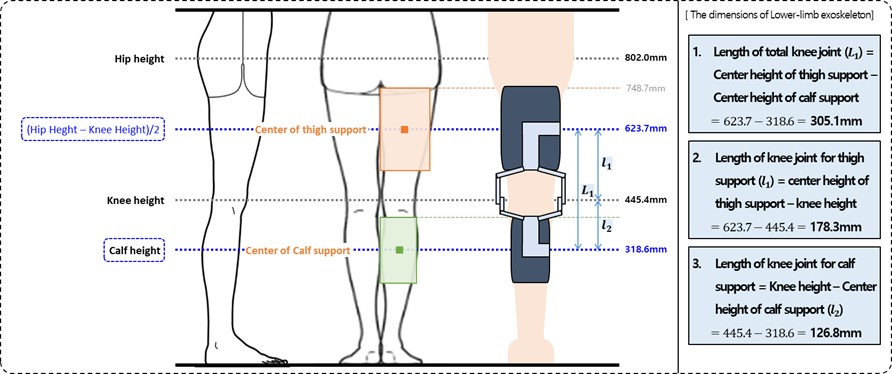
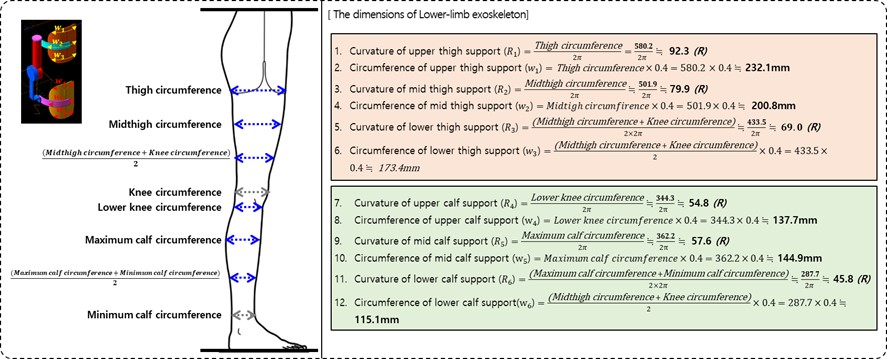
끝으로, ⑦ 무릎 관절부의 높이(height of knee joint)는 바닥면에서부터 445.4mm [knee height]; 무릎 관절부 전체 길이(length of total knee joint)는 305.1mm [center height of thigh support (632.7mm) – center height of calf support (318.6mm)], 허벅지 부위 무릎 관절 길이(length of knee joint for thigh part)는 178.3mm [center height of thigh support (623.7mm) – knee height (445.4mm)], 종아리 부위 무릎 관절 길이(length of knee joint for calf part)는 126.8mm [knee height (445.4mm) – center height of calf support (318.6mm)]로 정의하였다(Figure 3).
또한, 허벅지 받침과 종아리 받침이 이루는 각도의 경우, 사이즈 코리아의 방문을 통해 신체 3D 스캔 데이터를 수집한 결과 바르게 섰을 때와 편하게 섰을 때의 무릎 각도가 각각 평균 177.9°, 176.3°이었으며, 기존 문헌을 조사한 결과로는 평균 무릎 각도는 약 174.4~177.5°로 이루어진 것을 확인할 수 있었다(Hasegawa et al., 2016; Gong et al., 2019). 두 종류의 데이터를 함께 고려하여 시상면에서의 허벅지와 무릎이 이루는 각도를 175.0°로 정의하였다(Figure 5).
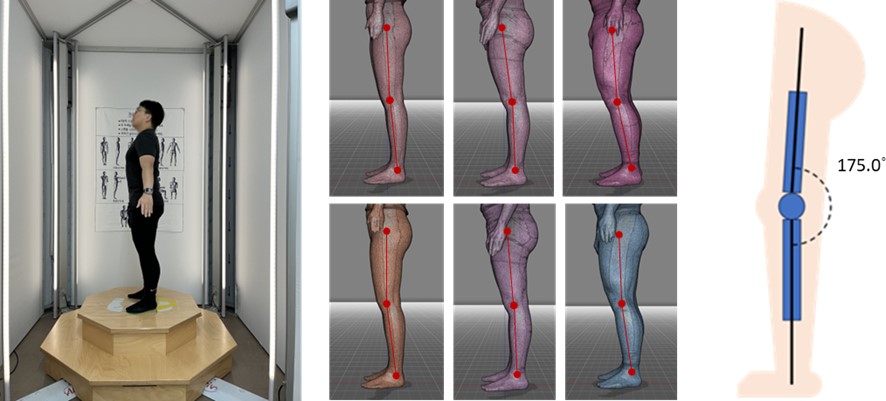
3.2 Prototype of the lower-limb exoskeleton
위의 제시한 치수를 모두 적용하여 하지 외골격 보조장치를 제작하였다. 또한, 착용 후 움직임 및 무게에 따른 외골격의 흘러내림을 방지하고자, 기존에 제시한 외골격 요소 외 무게 지지용 허리 벨트를 추가적으로 제작하였다(Figure 6). 제작된 외골격의 무릎 관절부 굽힘 각도는 다양한 하지 작업을 수행할 수 있도록, 다섯 단계(80°, 100°, 120°, 140°, 160°)로 각도 조절이 가능하도록 제작하였다.
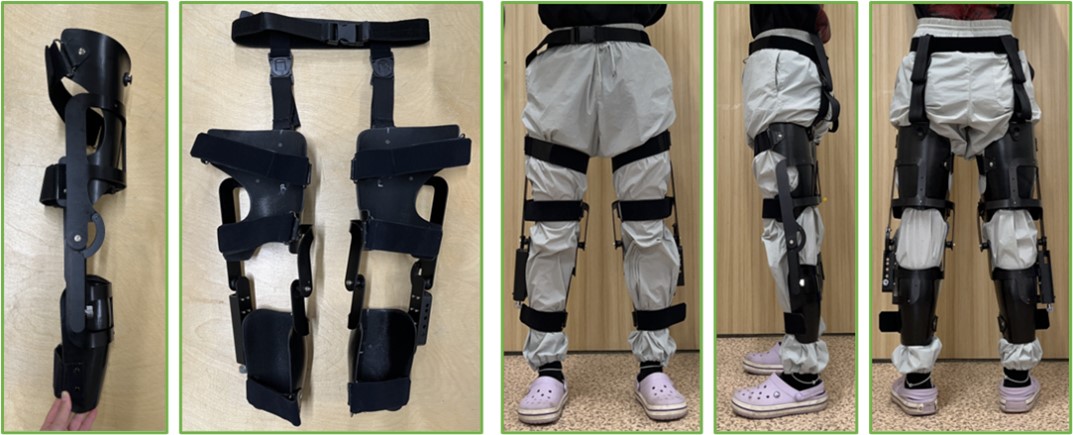
본 연구에서는 농업인의 다양한 농작업 수행을 보조할 수 있는 하지 외골격 보조장치의 제작 및 설계 항목들을 정의하기 위해, 각 항목들에 대해 Size Korea(8차; 2020~2023년) 20~69세 남녀의 인체치수 50%ile 데이터를 활용하여 설계 치수를 제시하였다. 또한, 하지 외골격 보조장치의 제작을 위해서 ① 허벅지 받침, ② 종아리 받침, 그리고 ③ 무릎 관절부로 분류하였다. 허벅지 받침과 종아리 받침의 경우, 각 받침부 중앙의 높이와 함께 받침부의 위, 가운데, 그리고 아래 부위의 둘레 데이터를 정의하였고, 무릎 관절부의 경우에는 무릎으로부터 허벅지와 종아리 받침까지의 길이, 그리고 허벅지 받침과 종아리 받침이 이루는 각도를 실험과 기존의 데이터를 기반으로 정의하였다. 따라서, 하지 외골격 보조장치의 각 부위와 부위별 설계 항목 및 치수 등의 정의를 기반으로 외골격 보조장치 프로토타입을 제작하였으며, 이후의 연구 계획 및 본 연구의 한계는 아래와 같다.
추후 연구 계획으로는, 본 연구에서 제작한 하지 외골격 보조장치에 대한 사용성 평가를 수행할 계획이다. 사용성 평가는 본 연구에서 개발한 하지 외골격 보조장치의 사용성 평가 프로토콜에 따라 진행하고자 한다(Hussain et al., 2023; Kong et al., 2023). 선행 연구에서 진행한 정성적 평가 방식에 따라 착용감, 안정감, 학습성과 같이 피험자가 하지 외골격 보조장치를 착용/미착용 상태로 보행 작업, TUG test, 농작업 simulation과 같은 작업을 수행할 때 경험할 수 있는 요소에 대해 설문을 이용하여 데이터를 수집 및 분석을 통해 제작된 보조장치에 대한 사용성을 평가하고자 한다. 또한, 객관적인 정량적 평가지표로서는 하지, 허리 및 상지 근육들에 대한 근육활성도(근전도, EMG)와 대상 작업을 수행할 때의 작업자의 동작을 분석하기 위해 모션 캡쳐(Xsens) 시스템과 같은 장비를 활용하여 인체역학적 평가지표를 기반으로 사용성 평가를 실시하고자 한다.
제작한 하지 외골격의 사용성 검토 및 개선점을 도출하기 위해 간단한 사용성 평가를 수행한 뒤 설문을 수행한 결과, 다음과 같은 문제점 및 개선안이 도출되었다. 하지 외골격 보조장치를 직접 착용해 보았을 때, 외골격의 무게로 인한 흘러내림 현상이 발견되었다. 따라서 추후 보조장치의 수정 작업을 위해서는 내구성이 뛰어나며 가벼운 재질의 사용을 고려해야 할 것으로 사료된다. 또한, 무릎 관절부의 굽힘 각도를 80~160° 총 5단계로 조절이 가능하도록 설계하였는데, 무릎 굴곡이 80°와 같이 굽혀지는 경우, 허벅지 받침대와 종아리 받침대가 만나는 간섭 현상으로 인해 무릎 굴곡에 방해가 되는 경향이 있어, 이를 방지하기 위해서는 각 받침대의 위치를 조절하거나 크기를 줄일 필요성이 있는 것으로 판단된다. 끝으로, 허벅지와 종아리 받침대의 체결을 위해서, 보아 시스템을 적용하였는데, 보아 시스템의 와이어 길이가 한정되어 있어 사용자에 따른 다양한 허벅지 및 종아리 둘레에 적용하는데 한계가 있었다. 따라서, 이러한 한계점을 극복하기 위해 착용과 탈착이 쉬운 벨크로 시스템을 대안으로 제안해 본다.
본 연구의 한계점은 데이터를 기반으로 하지 외골격 보조장치의 설계 치수를 정의한 후, 프로토타입을 제작 후, 착용해본 결과 프레임, 허벅지 및 종아리 받침대, 그리고 하네스 부분 등에 다양한 개선점이 발견되었다. 따라서, 추후 연구에서는 사용자 대상으로 한 사용성 평가를 통해 경험적인 요소를 바탕으로 한 주관적인 데이터를 반영하여 개선 사항을 도출할 뿐 아니라, 근활성도 및 모션 캡쳐 등의 장비를 이용한 객관적인 인체역학적 데이터를 기반으로 하지 외골격 보조장치의 사용성을 검증해야 할 것으로 보인다.
본 연구를 통해 설계되고 제작된 하지 외골격 보조장치를 개발함을 통해, 향후 다양한 농업현장에서 수행하는 작업들에 대한 농업인들의 허리 및 다리 부위의 작업 부담을 경감할 수 있는 도구로서 활용될 수 있기를 기대해 본다.
References
1. Ahn, H.S., Yoo, H.K. and Lee, S.K., Farmers' health care and fatigue awareness symptoms. Journal of Agricultural Education and Human Resource Development, 17(1), 43-48, 1985.
2. Cohen, A.L., Elements of ergonomics programs: a primer based on workplace evaluations of musculoskeletal disorders. DIANE Publishing, 1997.
Google Scholar
3. De Looze, M.P., Bosch, T., Krause, F., Stadler, K.S. and O'Sullivan, L.W., Exoskeletons for industrial application and their potential effects on physical work load. Ergonomics, 59(5), 671-681, 2016.
Google Scholar
4. Di Natali, C., Poliero, T., Sposito, M., Graf, E., Bauer, C., Pauli, C., Bottenberg, E., De Eyto, A., O'Sullivan, L., Hidalgo, A.F., Scherly, D., Stadler, K.S., Caldwell, D.G. and Ortiz, J., Design and evaluation of a soft assistive lower limb exoskeleton. Robotica, 37(12), 2014-2034, 2019.
Google Scholar
5. Gong, H., Sun, L., Yang, R., Pang, J., Chen, B., Qi, R., Gu, X., Zhang, Y. and Zhang, T., Changes of upright body posture in the sagittal plane of men and women occurring with aging – a cross sectional study. BMC Geriatrics, 19, 1-11, 2019.
Google Scholar
6. Hasegawa, K., Okamoto, M., Hatsushikano, S., Shimoda, H., Ono, M. and Watanabe, K., Normative values of spino-pelvic sagittal alignment, balance, age, and health-related quality of life in a cohort of healthy adult subjects. European Spine Journal, 25, 3675-3686, 2016.
Google Scholar
7. Howard, J., Murashov, V.V., Lowe, B.D. and Lu, M.L., Industrial exoskeletons: Need for intervention effectiveness research. American Journal of Industrial Medicine, 63(3), 201-208, 2020.
Google Scholar
8. Hussain, M., Kong, Y.K., Park, S.S., Shim, H.H. and Park, J., Exoskeleton Usability Questionnaire: a preliminary evaluation questionnaire for the lower limb industrial exoskeletons. Ergonomics, 1-10, 2023.
Google Scholar
9. Jung, H.S. and Jung, H.S., Evaluation of proper height for squatting stool and the ergonomic design of wearable stool. IE Interfaces, 18(3), 288-296, 2005.
Google Scholar
10. Kong, Y.K., Park, S.S., Shim, J.W., Kim, D.M., Kim, H.Y. and Shim, H.H., A study of the comparative evaluation system of the lower-limb exoskeleton. In International Conference on Human-Computer Interaction, 485-492, 2023.
Google Scholar
11. Lee, C.G., Work-related musculoskeletal disorders in Korean farmers. Journal of the Korean Medical Association, 55(11), 1054-1062, 2012.
Google Scholar
12. Lee, D.W., Jung, J.Y., Kim, B.S., Son, Y.K. and Shin, H.C., Trends in wearable assistive robotics technology. Electronics and Telecommunications Trends, 32(4), 21-30, 2017.
Google Scholar
13. Luger, T., Cobb, T.J., Seibt, R., Rieger, M.A. and Steinhilber, B., Subjective evaluation of a passive lower-limb industrial exoskeleton used during simulated assembly. IISE Transactions on Occupational Ergonomics and Human Factors, 7(3-4), 175-184, 2019.
Google Scholar
14. Meyers, J.M., Faucett, J., Tejeda, D.G., Kabashima, J., Miles, J.A., Janowitz, I., Duraj, V., Smith, R. and Weber, E., High risk tasks for musculoskeletal disorders in agricultural field work. In Proceedings of the Human Factors and Ergonomics Society Annual Meeting, 44(22), 616-619, 2000.
Google Scholar
15. Punnett, L. and Wegman, D.H., Work-related musculoskeletal disorders: the epidemiologic evidence and the debate. Journal of Electromyography and Kinesiology, 14(1), 13-23, 2004.
Google Scholar
16. Rashedi, E., Kim, S., Nussbaum, M.A. and Agnew, M.J., Ergonomic evaluation of a wearable assistive device for overhead work. Ergonomics, 57(12), 1864-1874, 2014.
Google Scholar
17. Rural Development Administration, Health promotion of agricultural work and ease of manpower agricultural work, Report on Agricultural Research and Development Project of Rural Development Administration, 1995.
18. Ruiz, C.I., Analysis of derived features for the motion classification of a passive lower limb exoskeleton. Master's thesis, Universitat Politècnica de Catalunya, 2019.
Google Scholar
19. Steinhilber, B., Seibt, R., Rieger, M.A. and Luger, T., Postural control when using an industrial lower limb exoskeleton: Impact of reaching for a working tool and external perturbation. Human Factors, 64(4), 635-648, 2022.
Google Scholar
20. Toxiri, S., Näf, M.B., Lazzaroni, M., Fernández, J., Sposito, M., Poliero, T., Monica, L., Anastasi, S., Caldwell, D.G. and Ortiz, J., Back-support exoskeletons for occupational use: an overview of technological advances and trends. IISE Transactions on Occupational Ergonomics and Human Factors, 7(3-4), 237-249, 2019.
21. Zhou, L., Chen, W., Chen, W., Bai, S., Zhang, J. and Wang, J., Design of a passive lower limb exoskeleton for walking assistance with gravity compensation. Mechanism and Machine Theory, 150, 103840, 2020.
Google Scholar
PIDS App ServiceClick here!